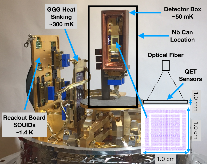Single electron–hole pair sensitive silicon detector with surface event discrimination
Abstract
Here, we demonstrate single electron-hole pair resolution in a single-sided, contact-free 1 cm$^2$ by 1 mm thick Si crystal operated at 48 mK, with a baseline energy resolution of 3 eV. This crystal can be operated at voltages in excess of $$\pm50$$ V, resulting in a measured charge resolution of 0.06 electron-hole pairs. The high aluminum coverage ($$\sim$$70%) of this device allows for the discrimination of surface events and separation of events occurring near the center of the detector from those near the edge. We use this discrimination ability to show that dark events seen in previous detectors of a similar design are likely dominated by charge leakage along the side wall of the device. We saw only a small reduction in dark event rate with this biasing scheme, further suggesting that sidewall and edge-dominated processes are responsible for the majority of these events.
- Authors:
-
- Northwestern Univ., Evanston, IL (United States)
- Fermi National Accelerator Lab. (FNAL), Batavia, IL (United States); Univ. of Chicago, IL (United States)
- Univ. of Montreal, QC (Canada)
- Univ. of California, Berkeley, CA (United States)
- Texas A & M Univ., College Station, TX (United States)
- Publication Date:
- Research Org.:
- Fermi National Accelerator Laboratory (FNAL), Batavia, IL (United States)
- Sponsoring Org.:
- USDOE Office of Science (SC), High Energy Physics (HEP); National Science Foundation (NSF)
- OSTI Identifier:
- 1542181
- Alternate Identifier(s):
- OSTI ID: 1776919
- Report Number(s):
- arXiv:1903.06517; FERMILAB-PUB-19-097-AE-E
Journal ID: ISSN 0168-9002; oai:inspirehep.net:1725230
- Grant/Contract Number:
- AC02-07CH11359; PHY-1809730
- Resource Type:
- Accepted Manuscript
- Journal Name:
- Nuclear Instruments and Methods in Physics Research. Section A, Accelerators, Spectrometers, Detectors and Associated Equipment
- Additional Journal Information:
- Journal Volume: 963; Journal ID: ISSN 0168-9002
- Publisher:
- Elsevier
- Country of Publication:
- United States
- Language:
- English
- Subject:
- 79 ASTRONOMY AND ASTROPHYSICS; 46 INSTRUMENTATION RELATED TO NUCLEAR SCIENCE AND TECHNOLOGY; Silicon calorimeter; Low-threshold; Dark matter; Quantization
Citation Formats
Hong, Ziqing, Ren, Runze, Kurinsky, Noah, Figueroa-Feliciano, Enectali, Wills, Lise, Ganjam, Suhas, Mahapatra, Rupak, Mirabolfathi, Nader, Nebolsky, Brian, Pinckney, H. Douglas, and Platt, Mark. Single electron–hole pair sensitive silicon detector with surface event discrimination. United States: N. p., 2020.
Web. doi:10.1016/j.nima.2020.163757.
Hong, Ziqing, Ren, Runze, Kurinsky, Noah, Figueroa-Feliciano, Enectali, Wills, Lise, Ganjam, Suhas, Mahapatra, Rupak, Mirabolfathi, Nader, Nebolsky, Brian, Pinckney, H. Douglas, & Platt, Mark. Single electron–hole pair sensitive silicon detector with surface event discrimination. United States. https://doi.org/10.1016/j.nima.2020.163757
Hong, Ziqing, Ren, Runze, Kurinsky, Noah, Figueroa-Feliciano, Enectali, Wills, Lise, Ganjam, Suhas, Mahapatra, Rupak, Mirabolfathi, Nader, Nebolsky, Brian, Pinckney, H. Douglas, and Platt, Mark. Fri .
"Single electron–hole pair sensitive silicon detector with surface event discrimination". United States. https://doi.org/10.1016/j.nima.2020.163757. https://www.osti.gov/servlets/purl/1542181.
@article{osti_1542181,
title = {Single electron–hole pair sensitive silicon detector with surface event discrimination},
author = {Hong, Ziqing and Ren, Runze and Kurinsky, Noah and Figueroa-Feliciano, Enectali and Wills, Lise and Ganjam, Suhas and Mahapatra, Rupak and Mirabolfathi, Nader and Nebolsky, Brian and Pinckney, H. Douglas and Platt, Mark},
abstractNote = {Here, we demonstrate single electron-hole pair resolution in a single-sided, contact-free 1 cm$^2$ by 1 mm thick Si crystal operated at 48 mK, with a baseline energy resolution of 3 eV. This crystal can be operated at voltages in excess of $\pm50$ V, resulting in a measured charge resolution of 0.06 electron-hole pairs. The high aluminum coverage ($\sim$70%) of this device allows for the discrimination of surface events and separation of events occurring near the center of the detector from those near the edge. We use this discrimination ability to show that dark events seen in previous detectors of a similar design are likely dominated by charge leakage along the side wall of the device. We saw only a small reduction in dark event rate with this biasing scheme, further suggesting that sidewall and edge-dominated processes are responsible for the majority of these events.},
doi = {10.1016/j.nima.2020.163757},
journal = {Nuclear Instruments and Methods in Physics Research. Section A, Accelerators, Spectrometers, Detectors and Associated Equipment},
number = ,
volume = 963,
place = {United States},
year = {Fri Mar 06 00:00:00 EST 2020},
month = {Fri Mar 06 00:00:00 EST 2020}
}
Figures / Tables:
 Fig. 1: A side view of the detector box mounted inside the ADR with the outer shielding removed. The inset picture shows the schematics of the detector used, together with the optical fiber and its field of illumination.
Fig. 1: A side view of the detector box mounted inside the ADR with the outer shielding removed. The inset picture shows the schematics of the detector used, together with the optical fiber and its field of illumination.
Works referenced in this record:
Thermal detection of single e-h pairs in a biased silicon crystal detector
journal, January 2018
- Romani, R. K.; Brink, P. L.; Cabrera, B.
- Applied Physics Letters, Vol. 112, Issue 4
Gram-scale cryogenic calorimeters for rare-event searches
journal, July 2017
- Strauss, R.; Rothe, J.; Angloher, G.
- Physical Review D, Vol. 96, Issue 2
Results on MeV-scale dark matter from a gram-scale cryogenic calorimeter operated above ground: CRESST Collaboration
journal, September 2017
- Angloher, G.; Bauer, P.; Bento, A.
- The European Physical Journal C, Vol. 77, Issue 9
Calorimetric ionization detector
journal, April 1990
- Luke, P. N.; Beeman, J.; Goulding, F. S.
- Nuclear Instruments and Methods in Physics Research Section A: Accelerators, Spectrometers, Detectors and Associated Equipment, Vol. 289, Issue 3
Single-Electron and Single-Photon Sensitivity with a Silicon Skipper CCD
journal, September 2017
- Tiffenberg, Javier; Sofo-Haro, Miguel; Drlica-Wagner, Alex
- Physical Review Letters, Vol. 119, Issue 13

 Search WorldCat to find libraries that may hold this journal
Search WorldCat to find libraries that may hold this journal